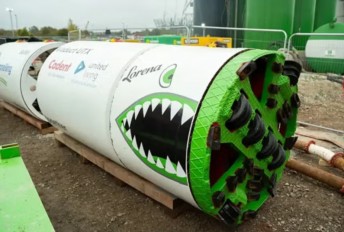A Breakthrough Achievement in Guangzhou's Baiyun Airport T3 Transportation Hub


Sources: nbmcw.com, tunnelsandtunnelling.com, southcn.com
Want to read more like this story?

Railway Innovation: Łódź Tunnel to Revolutionize Polish Transportation
Dec, 26, 2024 | NewsThe ambitious Łódź rail tunnel project is set to redefine Poland's transportation landscape, connec...

From Blueprint to Reality: HS2 Achieves Historic Tunneling Milestone
Mar, 13, 2025 | NewsThe HS2 project has reached a significant milestone with the completion of the first deep twin-bore...

Engineering Challenges Conquered: Saltley Viaduct Tunnel Finished
Dec, 04, 2024 | NewsThe tunnelling phase of the Saltley Viaduct Gas Diversion project has been successfully completed,...

Transatlantic Tunnel: A Bold Vision or an Impossible Dream?
Mar, 04, 2025 | NewsImagine traveling from New York to London in just 54 minutes—a journey that currently takes over se...

From 5.5 Hours to 3: How High-Speed Rail Will Change Travel in Canada
Mar, 05, 2025 | NewsCanada is set to embark on one of its most ambitious infrastructure projects—the 1,000-kilometre hi...

Progress and Challenges of HS2's Northolt Tunnel Project
Apr, 24, 2024 | NewsThe Northolt tunnel project under High Speed 2 (HS2) is making significant steps forward, with all...

HS2’s Northolt Tunnel Reaches Breakthrough After 14 Months of Continuous Excavation
Jul, 04, 2025 | NewsThe excavation of the 8.4-mile Northolt Tunnel under London marks a pivotal achievement in the HS2...

Tunnel Boring Meets Fault Zones: Insights from the Brenner Base Tunnel
Jan, 29, 2025 | NewsThe Brenner Base Tunnel (BBT), an ambitious railway infrastructure connecting Austria and Italy, i...

A Milestone in Mumbai's Sewage Disposal Project
Sep, 02, 2024 | NewsThe Mumbai Sewage Disposal Project (MSDP) has achieved a significant breakthrough with the completi...
Trending

Vertical gardens in Mexico City to combat pollution

Characteristics of Load Bearing Masonry Construction

Taipei 101’s impressive tuned mass damper

Dutch greenhouses have revolutionized modern farming

The Line at Neom faces feasibility reassessment while construction continues

The Line at Neom faces feasibility reassessment while construction continues

King Salman Gate unveiled adjacent to Mecca’s Grand Mosque

